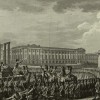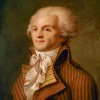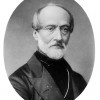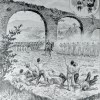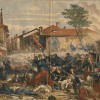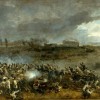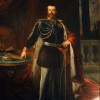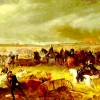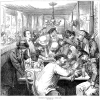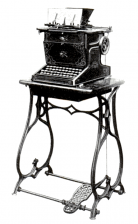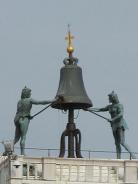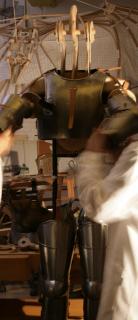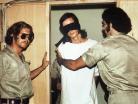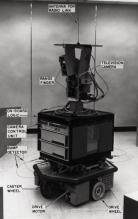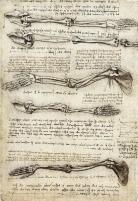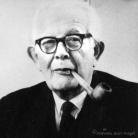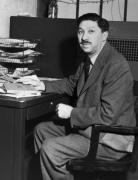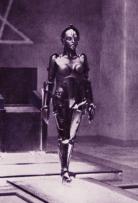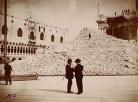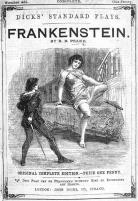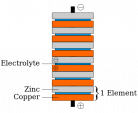in the year 1000, under Doge Pietro II Orseolo, Dalmatia was finally in complete control of the Venetians after many years of battle, tribute-payment, and political maneuvering in response to Dalmatian pirates. This marked the beginning of the Venetian empire. Image: the extent of the Kingdom of Dalmatia (blue), on a map of modern-day Croatia. This file is licensed under the Creative Commons Attribution Share Alike 3.0 Unported license.
Making the Human/ Inventing Venice
Created by Dino Franco Felluga on Fri, 12/30/2016 - 10:56
Part of Group:
This timeline allows students to see important events connected to the transition from Medieval to Renaissance Italy (focussed especially on Venice).
Timeline
Chronological table
|
Date |
Event | Created by | Associated Places | |
|---|---|---|---|---|
| circa. 2046 |
test for the futureThis is a future event |
Dino Franco Felluga | ||
| 12 Jan 2017 |
Europe calls for mandatory 'kill switches' on robotsOn January 12, 2017 CNN published an article discussing the proposal by European lawmakers for all robots to be equipped with emergency “kill switches.” The article discusses the main aspects of the proposal including all robots being required to be easily identified as mechanical beings, having kill switches, and following orders from the creator at all times. Image is a photo of the European Parliament’s hemicycle. Image by Diliff - Own work, CC BY-SA 3.0, https://commons.wikimedia.org/w/index.php?curid=35972521 |
Susannah Pritchett-Montavon | ||
| Autumn 2014 |
Restoration of the MoorsThe two statues that are located on top of the Clock Tower are known as the "Moors." Venetians came up with this name because the statues' bronze color have changed over time due to interacting with the elements. Due to deterioration, the Moors have not been able to strike the bell consistently. One Moor is supposed to strike the bell two minutes before the hour, while the other is supposed to strike it two minutes after the hour. Piaget agreed to finance the restoration of the Moors in 2014. Image By Yair Haklai (Own work) [CC BY-SA 4.0 (http://creativecommons.org/licenses/by-sa/4.0)], via Wikimedia Commons |
Mikaela Meyer | ||
| 2011 to 2011 |
IBM's WatsonIn 2011 IBM’s Watson competed on the hit TV show Jeopardy. Watson is a computer system designed to answer questions posed in natural language. Watson continuously outperformed its human components, including two of the most successful Jeopardy contestants, Ken Jennings and Ben Rutter. Image is of IBM employees demonstrating Watson’s ability to play Jeopardy. Image By Raysonho @ Open Grid Scheduler / Grid Engine - Own work, CC BY 3.0, https://commons.wikimedia.org/w/index.php?curid=14967544 |
Susannah Pritchett-Montavon | ||
| 2002 to 2002 |
Prototype of Da Vinci's Mechanical KnightIn 2002, Mark Rosheim built a prototype of da Vinci’s mechanical knight using the original schematics/notes. The construction of the knight proved that da Vinci’s original design was feasible and worked as intended. Mark Rosheim was inspired by da Vinci in his career with NASA where he designed robots. Image is a modern reconstruction of the mechanical knight in 2007 in the Leonardo3 laboratories. Image by Leonardo3 - Mario Taddei - Photo in the Leonardo3 Laboratories, GFDL, https://commons.wikimedia.org/w/index.php?curid=5666658 |
Susannah Pritchett-Montavon | ||
| 4 Jul 1997 to 27 Sep 1997 |
Sojourner Explores MarsOn July 4, 1997, Sojourner became the first successful Mars Pathfinder. The rover was autonomous and had front and rear cameras. The robot’s communication lasted until September 27, 1977. The rover was able to transmit approximately 550 images and more than 15 chemical analyses of rocks and soil throughout its lifespan. Image is a picture of the Sojourner. Public Domain, https://commons.wikimedia.org/w/index.php?curid=328753 |
Susannah Pritchett-Montavon | ||
| Mar 1989 |
Invention of the World Wide WebIn March of 1989, Sir Tim Berners-Lee began the layout of what would later be the World Wide Web. He graduated from Oxford and became a software engineer at CERN shortly after. While working for CERN, Berners-Lee created the proposal for the World Wide Web. He created HTTP, HTML, the first web browser, and the first HTTP server. This allows people to read and write on the internet via the use of computers. After its creation, the World Wide Web was primarily used for scientific researchers or science departments at universities. With time though there became more web servers all around the world. The World Wide Web has had such a drastic role in the current world of online technology and data collection. Sir Tim Berners-Lee was hugely influential and will remain an icon in the online world for many years to come. Image source: http://webfoundation.org/about/vision/history-of-the-web/ |
Caroline Brown | ||
| 14 Aug 1971 to 20 Aug 1971 |
Stanford Prison ExperimentPsychologist Philip Zimbardo masterminded this iconic experiment at Stanford University in the summer of 1971. He made a simulation of a jail and randomly assigned students to either the role of prisoner or guard. Zimbardo and associates wanted to answer the question of what causes the abuse between prisoners and guards in a prison. The experiment escalated quickly. Guards began abusing their power and unjustly punishing and harassing the prisoners. Zimbardo's simulation had morphed into something much more telling. This experiment is used as an example of the effects of power and hierarchy on behavior and is studied in most entry level psychology courses. Image source: http://www.cbsnews.com/pictures/shocking-prison-study-40-years-later-wha... |
Caroline Brown | ||
| 1966 to 1972 |
Shakey the Robot is DevelopedFrom 1966-1972, the Artifical Intelligence Center of Stanford institute developed the first robot with the ability to make its own decisions about how to behave. Shakey was able to receive, interpret, and execute natural language commands, even when they were multistep processes. Shakey was later inducted into the Carnegie Mellon Univerisyt’s Robot Hall of Fame in 2004. Image is a picture of Shakey the robot with its parts labelled. Image by SRI International - SRI International, CC BY-SA 3.0, https://commons.wikimedia.org/w/index.php?curid=17294520 |
Susannah Pritchett-Montavon | ||
| 1961 |
Unimate is InstalledIn 1961, General Motors installed the first industrial robot in its Inland Fisher Guide Plant in New Jersey. This robot was called Unimate and it was also the first modern programmable robot; it was autonomous and pre-programmed to repeatedly move pieces of hot metal in the plant. Image is an industrial robot used in metal manufacturing. Image by KUKA Roboter GmbH, Bachmann - KUKA Roboter GmbH, Zugspitzstraße 140, D-86165 Augsburg, Germany, Dep. Marketing, Mr. Andreas Bauer, http://www.kuka-robotics.com, Public Domain, https://commons.wikimedia.org/w/index.php?curid=3346503 |
Susannah Pritchett-Montavon | ||
| 1957 to 1957 |
Rediscovery of Leonardo da Vinci's NotebookIn 1957, Italian historian, Carlo Pedretti, rediscovered Leonardo da Vinci’s notebook. The notebook included the notes and sketches for da Vinci’s anatomical research and many mechanical designs, including the mechanical knight. The image is one of the pages from da Vinci’s notebook. The notes pictured are from his anatomical study of the human arm. Image: Public Domain, https://commons.wikimedia.org/w/index.php?curid=59576 |
Susannah Pritchett-Montavon | ||
| 25 Apr 1954 |
The First Practical Solar CellBell Laboratory scientists Calvin Fuller and Gerald Pearson announced the invention of the first practical silicon-based solar cell. These cells were later displayed at the National Academy of Science Meeting. This cell was also used to power a solar-powered radio transmitter, which broadcasted this meeting. Initially, the solar cells had an efficiency of 6%, but today commercial solar panels have up to 20% efficiency. The New York Times speculated that these cells "may provide more power than all the world's coal, oil, and uranium," which excited engineers around the globe. Image: Public Domain, https://commons.wikimedia.org/wiki/Solar_cell#/media/File:Solar_cell.png |
Ryan Gansemer | ||
| 1951 to 1953 |
St. Mark's Clock OverhaulGiovanni Peratoner was the custodian in 1951 when the overhaul began. The overhaul was necessary because the Tower building had moved slightly over time, so the bob did not reach the room below it. In order to overhaul the movement, Peratoner raised the pendulum's point of suspension. The clock was up and running again in 1953. Image by By Juan Manuel Caicedo [CC BY-SA 2.0 (http://creativecommons.org/licenses/by-sa/2.0)], via Wikimedia Commons |
Mikaela Meyer | ||
| 1950 to 1980 |
Psychological Cognitive RevolutionThe Cognitive Revolution in psychology was prompted by the Behaviorism movement. The Behaviorists focused their research primarily on observable behavior alone, completely disregarding any mental events because they couldn't be directly observed. Famous behaviorists include Ivan Pavlov and John Watson. Cognitive psychologists believe that the mind is complex and there are many different explanations for behavior. They tend to use a computer metaphor, with the hardware being what humans biologically have and the software being cognitions and patterns of thought. The cognitive revolution changed the world of psychology completely and helped shape it into the one we know today. Image source: http://www.creativitycenter.ch/bloc_deroulant/jean-piaget-and-genetic-ep... |
Caroline Brown | ||
| 1943 |
Maslow's Hierarchy of NeedsAbraham Maslow is a humanist psychologist who focused his research on the positive qualities that people possess, rather than seeing them as a bag of issues that needs to be fixed. The humanist movement in psychology helped shape the current world of psychology and focuses on how people are innately good and capable of changing their own worlds. The hierarchy of needs is based around the idea of self actualization, which is the top of the pyramind. Only 1 in 100 people achieve self-actualization by the end of their lifetime. Each level must be fulfilled before proceeding on to the next. The bottom of the pyramid is physiological needs like water, shelter, and rest. The next level is safety needs, then belongingness, esteem, and finally self-actualization. The pyramid progresses in a way that each section of a person's life fits in to one of the categories. When you're born you mostly just need rest and to be fed. Then as you get older your needs become more complex. Image source: http://www.huffingtonpost.com/steve-mariotti/how-to-get-from-here-to-t_b... |
Caroline Brown | ||
| 1927 |
Metropolis Film is ReleasedIn 1927, Metropolis was the first movie to portray a humanoid robot in film. This piece is one of the first works of the science-fiction genre. In Metropolis, the son of the city ruler and a poor worker team up to try and overcome the large separation between the classes in this futuristic urban dystopia. Image is a picture of the humanoid robot from the movie Metropolis retrieved from Unknown - archivio personale, Public Domain, https://commons.wikimedia.org/w/index.php?curid=43577653. |
Susannah Pritchett-Montavon | ||
| 17 Dec 1903 |
First Powered Human FlightWilbur and Orvill Wright were the first to perform a powered fight on what would become the precursor to all modern aircraft. The pair of brothers observed birds and avidly read the work of Sir George Cayley to create their aircraft. Leading up to the first successful aircraft, they preformed preliminary wind tunnel testing in their bicycle shop to predict aircraft performance, combined a rudder with warped wings to perform coordinated turns, developed their own gas powered engine, and created a highly efficient professor. Their first famous flight in Kitty Hawk North Carolina lasted for 12 seconds and flew 120 feet. The Wright brothers flew multiple times that day, the longest lasting 59 seconds and travelling 852 feet. This marked the beginning of the development of the aircraft that is used today. The image is from the first day of flight and is from Wikimedia commons. |
Catriona White | ||
| 14 Jul 1902 |
St. Mark's Campanile CollapsesThe Campanile (bell tower) collapsed suddenly due to multiple construction flaws. No one died in the collapse except for the Campanile's custodian's cat. Fortunately, the church was saved because the corner column did not collapse. The Municipal Administration promised that the Campanile would be rebuilt just as it was. This is an image of the ruins after the collapse. See page for author [Public domain], via Wikimedia Commons, https://commons.wikimedia.org/wiki/File%3ARuins_of_St_Mark's_Campanile.jpg |
Mikaela Meyer | ||
| 1885 |
The Battleship Francesco MorosiniIn the year 1885 at the Arsenal of Venice, the first Venetian battleship, Franceso Morosini, was built. Venice was able to produce such a large ship thanks to scientific advancements such the Bessemer Process which made mass production of steel a lot quicker than ever before. However, even though the construction of this ship was a great feat, the late 1800s were the last of Arsenal of Venice's days of large production of naval ships. The Francesco Morosini marks the end of an era for Venice as its days of superior naval production are long past. Source: From craft production to industrial production. (n.d.). Retrieved February 07, 2017, from http://arsenalofvenice.weebly.com/from-craft-production-to-industrial-production.html This photograph is in the public domain in Italy because it was first published in Italy and its term of copyright has expired. According to Law for the Protection of Copyright and Neighbouring Rights n.633, 22 April 1941 |
Jacob Hussey | ||
| 1884 |
The First Practical Electric CarThomas Parker, an inventor from London and leading researcher in batteries and electricity at the time, built the first production car to be electric-powered. These galvanic cell-powered vehicles were built using Parker's own high-capacity rechargeable batteries. Parker dedicated his life to the development and manufacturing of more fuel-efficient cars and the optimization of galvanic battery cell chemistry. This interest was a result of his concern about the detrimental effects of smoke and pollution in urban London. Image source: Public Domain, https://upload.wikimedia.org/wikipedia/commons/e/e7/Thomas_Parker_Electr... |
Ryan Gansemer | ||
| 1884 |
Invention of the Linotype MachineThe linotype machine was invented in 1884 by Ottmar Mergenthaler in the United States of America. A linotype machine works with a matrix molded system. An operator can type the desired text in a keyboard on the machine and the machine will fill in the letters required for each line of text, including spaces. The linotype machine revolutionized the process of printing, especially items, such as newspaper, that required many small lines of text. This image was sourced from Wikimedia Commons. |
Laura Titzer | ||
| 1879 |
First Psychology LabThe world's first psychology lab was founded by Wilhelm Wundt at the University of Leipzig in Germany. This event is viewed as what catapulted psychology into the world of academia, taking it from a theoretical discipline to a scientific one. The creation of the lab truly turned psychology into its own discipline, rather than just a mixture of biology and philosophy. Wundt did research primarily on structuralism, which breaks down cognitions into their components and studying those basics elements. Image source: http://psychclassics.yorku.ca/Munster/Lab/ |
Caroline Brown | ||
| 2 Oct 1870 |
Rome annexed to ItalyPlebiscite annexes Rome and Latium to the Kingdom of Italy, 2 October 1870. This event marks the final phase of the unification of Italy. ArticlesAlison Chapman, "On Il Risorgimento" Related ArticlesMarjorie Stone, “On the Post Office Espionage Scandal, 1844″ |
David Rettenmaier | ||
| 19 Jul 1870 to 10 May 1871 |
Franco-Prussian War
ArticlesAlison Chapman, "On Il Risorgimento" Related ArticlesMarjorie Stone, “On the Post Office Espionage Scandal, 1844″ |
David Rettenmaier | ||
| 14 Jun 1866 to 2 Aug 1866 |
Austro-Prussian War
ArticlesAlison Chapman, "On Il Risorgimento" Related ArticlesMarjorie Stone, “On the Post Office Espionage Scandal, 1844″ |
David Rettenmaier | ||
| 1866 |
Kingdom of Italy revitalizes the Arsenal of VeniceIn 1866, after Venice became a part of the Kingdom of Italy, the Italians decided to modernize the Arsenal of Venice to help it be able to make steam-powered naval units such as the the "Ironclad" made famous in the American Civil War. Although the Italians had to make changes to the structure for the new classes of naval vessels, it desired to make sure the historic parts of it remain the same. This tradition off kepping Venice the same way it was back centuries prior still continues to this day. Source: http://www.venicethefuture.com/schede/uk/316?aliusid=316 This work is in the public domain in its country of origin and other countries and areas where the copyright term is the author's life plus 100 years or less. |
Jacob Hussey | ||
| 14 Jul 1862 to 6 Feb 1918 |
Life of Gustav KlimtArtist Gustav Klimt was born in Baumgarten, Austrian Empire on July 14, 1862. Klimt was influential in the Vienna Secession movement and devoted his life to his work, with a particular interest in painting the female body. Klimt's most famous work is his piece The Kiss (Lovers) which he finished in 1908 during his "Golden Period". This period was named as such because many of his works included gold leaf and were primarily painted in the color gold. Klimt was a controverisal artist who pushed the boundaries and even made the public feel uncomfortable at times with his erotic pieces. His depictions of the naked female body are very reminiscent of Renaissance period artwork. Image source: http://www.leopoldmuseum.org/en/leopoldcollection/focus/Klimt |
Caroline Brown | ||
| 1 Feb 1861 |
Italy is united
ArticlesAlison Chapman, "On Il Risorgimento" Related ArticlesMarjorie Stone, “On the Post Office Espionage Scandal, 1844″ |
David Rettenmaier | ||
| Jan 1861 |
Social Aspects of the Italian RevolutionIn January 1861, publication of Theodosia Trollope's Social Aspects of the Italian Revolution, a collection of Trollope’s essays on the Tuscan uprisings of 1859-1860, originally published in the Athenaeum. ArticlesAlison Chapman, "On Il Risorgimento" Related ArticlesMarjorie Stone, “On the Post Office Espionage Scandal, 1844″ |
David Rettenmaier | ||
| 12 Mar 1860 |
Poems before Congress
ArticlesAlison Chapman, "On Il Risorgimento" Related ArticlesMarjorie Stone, “On the Post Office Espionage Scandal, 1844″ |
David Rettenmaier | ||
| 24 Jun 1859 |
Battle of Solferino
ArticlesAlison Chapman, "On Il Risorgimento" Related ArticlesMarjorie Stone, “On the Post Office Espionage Scandal, 1844″ |
David Rettenmaier | ||
| 4 Jun 1859 |
Battle of Magenta
ArticlesAlison Chapman, "On Il Risorgimento" Related ArticlesMarjorie Stone, “On the Post Office Espionage Scandal, 1844″ |
David Rettenmaier | ||
| 1857 to 1859 |
St. Mark's Clock Adds Digital FormatThe building and mechanism required repair in the 1850s. The custodian and a clock technician wrote a technical brief about the state of the Clock Tower and the repairs they deemed necessary to complete. Luigi De Lucia was tasked with making these repairs. Also, a committee asked him to figure out a way to show the time in the dark. De Lucia decided to use illuminated panelled wheels that display the time in five minute intervals. This addition was one of the first tower clocks that used a digital format. Image By Tony Hisgett from Birmingham, UK (Clock Tower St Mark's Square 3 Uploaded by tm) [CC BY 2.0 (http://creativecommons.org/licenses/by/2.0)], via Wikimedia Commons |
Mikaela Meyer | ||
| 1853 |
First Human Glider FlightSir George Cayley, an English engineer, was the first to successfully study and understand the underlying principles associated with powered flight, as well as the first to accomplish unpowered flight without use of a balloon. He was the first to theorize about fixed wing aircraft, and determined that the system would need a separate propulsion system and a stabilizing tail. He also determined that the wings of an aircraft would need to be curved (have camber) to efficiently generate lift. He would go on to be the first human to fly on a glider in 1853, proving his theories on lift and aviation. His work greatly influenced the Wright Brothers and their invention of the powered aircraft. The included image is his glider, published in Mechanics Magazine in 1852, and found on Wikimedia. |
Catriona White | ||
| 9 Feb 1849 to Jul 1849 |
Roman Republic
ArticlesAlison Chapman, "On Il Risorgimento" Related ArticlesMarjorie Stone, “On the Post Office Espionage Scandal, 1844″ |
David Rettenmaier | ||
| 4 Mar 1848 |
Illustrated London News's "The French Revolution"
ArticlesJo Briggs, “1848 and 1851: A Reconsideration of the Historical Narrative” |
David Rettenmaier | ||
| 1 Feb 1848 |
Tuscan uprising
To supporters of Italian independence, the short-lived uprising in Tuscany, leading to a new constitution as well as freedom of the press and of religious practice, seemed to be the first step to overthrowing foreign rulers ArticlesAlison Chapman, "On Il Risorgimento" ArticlesMarjorie Stone, “On the Post Office Espionage Scandal, 1844″ |
David Rettenmaier | ||
| 2 Jul 1844 |
House of Commons investigates Post Office spying
Articles“On the Post Office Espionage Scandal, 1844″ Kate Lawson, “Personal Privacy, Letter Mail, and the Post Office Espionage Scandal, 1844″ |
David Rettenmaier | ||
| 2 Jul 1844 |
Bandiera brothers executed
Related ArticlesMarjorie Stone, “On the Post Office Espionage Scandal, 1844″ |
David Rettenmaier | ||
| 19 Jun 1844 |
Carlyle letter on Mazzini published
ArticlesMarjorie Stone, “On the Post Office Espionage Scandal, 1844″ Kate Lawson, “Personal Privacy, Letter Mail, and the Post Office Espionage Scandal, 1844″ |
David Rettenmaier | ||
| 14 Jun 1844 |
Petition on Post Office spying
ArticlesMarjorie Stone, “On the Post Office Espionage Scandal, 1844″ Kate Lawson, “Personal Privacy, Letter Mail, and the Post Office Espionage Scandal, 1844″ |
David Rettenmaier | ||
| Jan 1837 |
Mazzini's arrival in London
ArticlesMarjorie Stone, “On the Post Office Espionage Scandal, 1844″ Kate Lawson, “Personal Privacy, Letter Mail, and the Post Office Espionage Scandal, 1844″ Related Articles |
David Rettenmaier | ||
| 1823 |
Mary Shelley's FrankensteinThe first edition of Mary Shelley's Frankenstein was published anonymously in 1818, but the version with her name on the cover wasn't published until 1823. Shelley gained inspiration from traveling around Europe with future husband Percy Shelley and Lord Byron. They participated in ghost story telling competitions while traveling around, which is where some of her inspiration came from. Frankenstein tells the tale of Victor Frankenstein, a young scientist who creates a hideous creature and the trials of the creature after being abandoned by Frankenstein. The novel implements the frame story narrative style of storytelling, which was unique at the time. Her novel fuses together the genres of Gothic fiction with the notions of the Romantic movement. It's also seen as early science fiction work. The idea for the novel came to Shelley in a dream that later became the basis for Frankenstein. Mary Shelley's novel was hugely influential on the world of science fiction and horror. Image source: http://frankensteinia.blogspot.com/2008/08/mary-shelley-meets-frankenste... |
Caroline Brown | ||
| 26 May 1805 |
Napoleon made king of Italy
In a flamboyant and highly theatrical gesture, Napoleon Bonaparte signifies his political and military dominance over the Italian peninsula with a ceremony in Milan Cathedral, where he crowned himself King of Italy with the ancient, iconic iron crown of Lombardy. This crowning of Napoleon as King is a result of the French conquest of Italy. His full title was "Emperor of the French and King of Italy." ArticlesAlison Chapman, "On Il Risorgimento" Related Articles |
David Rettenmaier | ||
| 1800 to 1815 |
Napolean and the Arsenal of VeniceIn the early parts of the nineteenth century, Napolean and France had taken over the Italian Penisula including Venice. Napolean made some changes to the Arsenal of Venice including updating and modernizing the area to match the shipbuilding system of the French Empire. The Arsenal of Venice also became the base of operations of the Adriatic Sea for the French fleet. Source: http://arsenalofvenice.weebly.com/history-of-the-arsenale.html. This work is in the public domain in its country of origin and other countries and areas where the copyright term is the author's life plus 100 years or less |
Jacob Hussey | ||
| 1800 |
Volta Invents the First Chemical BatteryAlessandro Volta, an Italian physicist and chemist, created the first chemical battery, and as a result, founded the discipline of electrochemistry. The battery, called the voltaic pile, was one of the first chemical cells consisting of a zinc electrode and a copper electrode with saltwater brine as the electrolyte. This discovery of a way to create constant electric current led to more electricity-related discoveries later in the century. Image source: Public Domain, https://upload.wikimedia.org/wikipedia/commons/0/06/Voltaic_pile.svg |
Ryan Gansemer | ||
| 5 Sep 1793 to 27 Jul 1794 |
Reign of Terror
On 5 September 1793, the National Convention, France’s ruling body from 1793 to 1795, officially put into effect terror measures in order to subdue opposition to and punish insufficient support for the revolution and the new regime. From the autumn of 1793 until the summer of 1794, thousands of people across the country were imprisoned and executed (including the Queen) under the ruthless leadership of Maximilien Robespierre. The guillotine, particularly the one in Paris’s Place de la Révolution, served as the bloody emblem of the fear tactics that began to manifest themselves first in the formation of the Committee of Public Safety (6 April 1793) and subsequently in the implementation of the Law of Suspects (17 September 1793). The Terror ended on 27 July 1794 with the overthrow of Robespierre, who was guillotined the next day. ArticlesDiane Piccitto, "On 1793 and the Aftermath of the French Revolution" |
David Rettenmaier | ||
| 21 Jan 1793 |
Execution of King Louis XVI
1793 was a key juncture in the revolution, beginning with this execution on 21 January. The increasing violence prompted Britain to cut its ties to France, leading to declarations of war by the two countries. Violence peaked during the Reign of Terror (5 September 1793 – 27 July 1794), which resulted in the execution of the Queen (16 October) as well as of many suspects of treason and members of the Girondins, the more moderate faction that the radical Jacobins brought down on 2 June 1793 ArticlesDiane Piccitto, "On 1793 and the Aftermath of the French Revolution" |
David Rettenmaier | ||
| 5 May 1789 to 10 Nov 1799 |
French Revolution
On 5 May 1789, the Estates-General, representing the nobility, the clergy, and the common people, held a meeting at the request of the King to address France’s financial difficulties. At this meeting, the Third Estate (the commoners) protested the merely symbolic double representation that they had been granted by the King. This protest resulted in a fracture among the three estates and precipitated the French Revolution. On 17 June, members of the Third Estate designated themselves the National Assembly and claimed to represent the people of the nation, thus preparing the way for the foundation of the republic. Several pivotal events followed in quick succession: the storming of the Bastille (14 July), the approval of the Declaration of the Rights of Man and of the Citizen (26 August), and the march on Versailles that led to the enforced relocation of the royal family to Paris (5-6 October). These revolutionary acts fired the imagination of many regarding the political future of France, and, indeed, all of Europe. The republican period of the revolution continued in various phases until 9-10 November 1799 when Napoleon Bonaparte supplanted the government. ArticlesDiane Piccitto, "On 1793 and the Aftermath of the French Revolution" |
David Rettenmaier | ||
| 1759 |
St. Mark's Clock Tower Magi Schedule ChangedOn the original Clock Tower, there was carousel of Magi following an angel playing a trumpet. Thanks to a type of organ pipe, the trumpet actually played a sound. After the movement renovation was completed in 1757, Ferracina repaired the Magi carousel. He finished in 1759, and at that time, the carousel's schedule was changed. Now, the procession is only shown fifteen days out of the year. When the procession occurs, the Magi and angel pass in front of this statue of the Virgin Mary. Image By Tony Hisgett from Birmingham, UK (Clock Tower St Mark's Square 3 Uploaded by tm) [CC BY 2.0 (http://creativecommons.org/licenses/by/2.0)], via Wikimedia Commons |
Mikaela Meyer |


